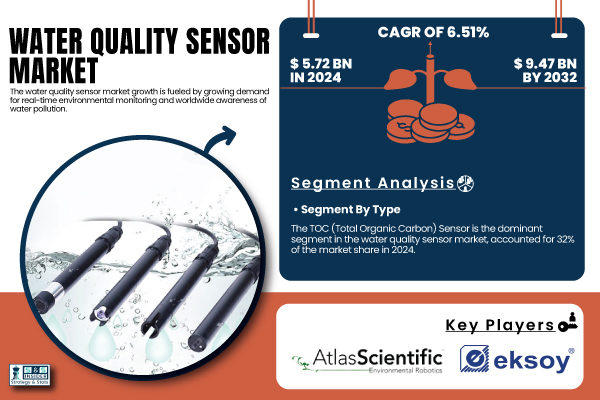Water Quality Sensor Market to Hit USD 9.47 Billion by 2032, Owing to the Growing Need for Real-Time Water Quality Monitoring and Regulatory Compliance | Research by SNS Insider
Rapid urbanization, rising environmental regulations, and the global emphasis on safe drinking and industrial water have spurred unprecedented demand for water quality sensor technologies, driving extensive deployment of IoT-enabled and real-time monitoring solutions across industries, municipalities, and agricultural sectors.
Austin, June 29, 2025 (GLOBE NEWSWIRE) -- The water quality sensor market size was valued at USD 5.72 billion in 2024 and is expected to reach USD 9.47 billion by 2032, growing at a CAGR of 6.51 % over the forecast period of 2025–2032. The surge in industrial water discharge and frequent contamination events has accelerated the adoption of advanced sensors for continuous monitoring. With the increasing need to detect contaminants like heavy metals, pathogens, and chemicals, stakeholders are turning to high-precision TOC, pH, and multi-parameter sensors.
The U.S. water quality sensor market is projected to grow from USD 1.83 billion in 2024 to USD 2.94 billion by 2032, at a CAGR of 6.14 %. This acceleration is being driven by stricter regulations on wastewater discharge, rising instances of waterborne illnesses prompting real-time detection, and the integration of sensor data with cloud analytics for predictive maintenance and early contamination alerts.

Download PDF Sample of Water Quality Sensor Market @ https://www.snsinsider.com/sample-request/7463
Key Players:
- Atlas Scientific LLC
- Eksoy Ltd.
- TriOS Mess- und Datentechnik GmbH
- Thermo Fisher Scientific .
- Endress+Hauser Group
- OTT Hydromet (Hach Company)
- Thames Water Utilities Limited
- Libelium Comunicaciones Distribuidas S.L.
- Time Warner Cable .
- Honeywell .
Water Quality Sensor Market Report Scope:
| Report Attributes | Details |
| Market Size in 2024 | USD 5.72 Billion |
| Market Size by 2032 | USD 9.47 Billion |
| CAGR | CAGR of 6.51% From 2025 to 2032 |
| Base Year | 2024 |
| Forecast Period | 2025-2032 |
| Historical Data | 2021-2023 |
| Report Scope & Coverage | Market Size, Segments Analysis, Competitive Landscape, Regional Analysis, DROC & SWOT Analysis, Forecast Outlook |
| Key Drivers | • Rising Water Pollution Fuels Demand for Real-Time Monitoring Solutions. |
If You Need Any Customization on Water Quality Sensor Market Report, Inquire Now @ https://www.snsinsider.com/enquiry/7463
TOC Sensors Dominate by Type and Industrial Applications Lead End-Use Segment, Owing to the High Demand for Real-Time Monitoring, Regulatory Compliance, and Smart Integration
By Type
The TOC (Total Organic Carbon) Sensor segment holds the leading position in the water quality sensor industry, capturing 32% of the market share in 2024. Its capacity to measure organic pollution in various kinds of water sources, including drinking water, industrial effluent, and municipal wastewater, accounts for its wide range of applications. Through the precise, real-time reporting of organic pollutants, TOC Sensors are essential to environmental preservation and regulatory compliance. They are improved for automated use by their compatibility with digital platforms and sophisticated monitoring systems.
By End-Use
The Industrial segment dominates the market for water quality sensors, which accounts for 36% of the overall market share in 2024. The enormous need for water quality testing in the petrochemical, food and beverage processing, pharmaceutical, and power generating sectors is what drives this supremacy. To ensure product safety, improve process efficiency, and adhere to environmental standards, these sectors require accurate water quality data. Frequent monitoring is necessary since industrial enterprises typically face issues with wastewater discharge, chemical contamination, and water reuse.
North America Leads in Water Quality Sensor Adoption, While Asia Pacific Emerges as the Fastest-Growing Region Driven by Urbanization and Pollution Control Needs
North America held the largest share in the water quality sensor market in 2023, accounting for more than 42%. This leadership is the result of significant investments made to upgrade infrastructure and water monitoring systems. The region has been forced to act due to dated water facilities, stricter Clean Water Act regulations, and public concerns over water safety. Utilities and localities across the United States and Canada have started deploying advanced sensor networks that monitor real-time measurements of heavy metals, TOC, chlorine, turbidity, and pH. These technologies make it possible to identify issues early and carry out necessary maintenance. Federal and state-level incentive programs and grants have also been significant factors in driving usage.
The Asia Pacific region is experiencing the fastest growth in the water quality sensor market. Rapid industrialization and urbanization have led to serious problems with water pollution. Countries like China, India, and Southeast Asia are dealing with increasing levels of contamination in their surface and groundwater, mostly due to industrial waste and agricultural runoff. In response, governments and urban planners are putting extensive water monitoring programs into place. Critical characteristics, including pH, conductivity, dissolved oxygen, and nutrient levels, are being monitored in rivers, cities, and treatment facilities using Internet of Things-based sensors. At the same time, a number of infrastructure projects are increasing investment in municipal water treatment facilities. The market is also being driven by an increase in local R&D, with a focus on creating smaller, less expensive sensors.

Buy Full Research Report on Water Quality Sensor Market 2025-2032 @ https://www.snsinsider.com/checkout/7463
About Us:
SNS Insider is one of the leading market research and consulting agencies that dominates the market research industry globally. Our company's aim is to give clients the knowledge they require in order to function in changing circumstances. In order to give you current, accurate market data, consumer insights, and opinions so that you can make decisions with confidence, we employ a variety of techniques, including surveys, video talks, and focus groups around the world.
CONTACT: Jagney Dave - Vice President of Client Engagement Phone: +1-315 636 4242 (US) | +44- 20 3290 5010 (UK)



